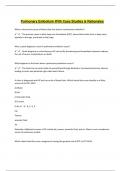Pulmonary Embolism With Case Studies & Rationales
What is the primary cause of blood clots that lead to a pulmonary embolism?
✔️✔️ The primary cause is often deep vein thrombosis (DVT), where blood clots form in deep veins,
typically in the legs, and travel to the lungs.
Why is quick diagnosis crucial in pulmonary embolism cases?
✔️✔️ Quick diagnosis is critical because PE can be life-threatening and immediate treatment reduces
the risk of severe complications or death.
What happens to the heart when a pulmonary embolism occurs?
✔️✔️ The heart has to work harder to pump blood through blocked or narrowed pulmonary arteries,
leading to strain and potential right-sided heart failure.
A client is diagnosed with PE but has no hx of blood clots. Which should the nurse identify as a likely
source of the PE? SATA
A) Water
B) Fat
C) Amniotic Fluid
D) Tumors
E) Air ✔️✔️B, C, D, E
Fat
Tumors
amniotic fluid
Air
Rationale: Additional sources of PE include fat, tumors, amniotic fluid, and air. Water is not considered a
source of pulmonary emboli.
Which client shold the nurse recognize as having the greatest risk of DVT or PE? SATA
,A) a 24 year old male in a traction device after femur fracture
B) A 55 year old female scheduled for a hysterectomy
C) A 32 year old female with an asthma exacerbation
D) A 65 year old male recovering from myocardial infarction
E) A 19 year old pregnant female with gestational diabetes. ✔️✔️A, B, D, E
Rationale: Pregnancy, fracture of long bones (especially the femur), reproductive surgery, and
myocardial infarction are all factors that increase the risk of the development of DVT or PE. Asthma
alone is not a risk factor for these conditions.
What are the early warning signs of a pulmonary embolism?
✔️✔️ Early signs can include mild chest pain, increased heart rate, anxiety, and slight shortness of
breath.
How can a pulmonary embolism affect the lungs in the long term?
✔️✔️ Long-term effects on the lungs can include reduced lung function, chronic thromboembolic
pulmonary hypertension (CTEPH), and increased difficulty with physical exertion.
What kinds of medications are typically used to prevent blood clots from forming after a pulmonary
embolism?
✔️✔️ Anticoagulants like heparin, warfarin, or newer oral anticoagulants are commonly prescribed to
prevent further clotting.
Can a pulmonary embolism be detected through a standard X-ray?
✔️✔️ No, a standard chest X-ray cannot confirm PE, but it may help rule out other conditions;
specialized imaging, like CT angiography, is needed.
What surgical options exist for treating pulmonary embolism?
✔️✔️ Surgical options include embolectomy, where the clot is physically removed, or catheter-
directed thrombolysis, where clot-dissolving drugs are delivered directly.
How does pregnancy affect the risk of pulmonary embolism?
, ✔️✔️ Pregnancy increases clotting risk due to hormonal changes, increased blood volume, and, at
times, limited mobility, raising the chance of DVT and PE.
What role does genetic predisposition play in pulmonary embolism risk?
✔️✔️ Genetic factors can increase clotting risk, especially in those with inherited clotting disorders,
such as Factor V Leiden.
How can prolonged bed rest or immobilization contribute to pulmonary embolism?
✔️✔️ Lack of movement slows blood flow in the legs, increasing the risk of clots forming and
potentially leading to a pulmonary embolism.
Why might a pulmonary embolism cause sudden death in severe cases?
✔️✔️ A large clot can suddenly block blood flow to the lungs, cutting off oxygen and causing rapid
cardiovascular collapse, which can be fatal.
What lifestyle factors can reduce the recurrence of pulmonary embolism in patients?
✔️✔️ Staying active, maintaining a healthy weight, avoiding long periods of sitting, and following a
doctor’s treatment plan can help reduce recurrence.
Why is it important to monitor patients on anticoagulant therapy closely?
✔️✔️ Close monitoring ensures appropriate dosing to balance the risk of bleeding complications with
effective prevention of further clotting.
Can individuals fully prevent pulmonary embolism?
✔️✔️ While full prevention isn’t guaranteed, reducing risk factors and managing conditions like DVT
significantly lowers the likelihood of occurrence.
What immediate steps should be taken if a pulmonary embolism is suspected?
✔️✔️ Immediate medical attention is required; doctors may perform tests like a D-dimer, CT scan, or
ultrasound to confirm the diagnosis quickly.




